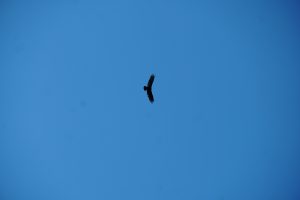Wildlife From The Water
May 17, 2021 by MATT ORRELL, UMIAK OUTDOOR OUTFITTERS
The Green Mountains are once again finally shedding their icy blankets. The sights and sounds of rebirth start to spring to life—whether it’s the morning cry of a baby robin, the tenacious tulips poking through the thawing soil or, our favorite sounds, the splashing of paddles. Once again, this harmonious marriage of water and blade, paddler and craft, is upon us. As our world turns to familiar shades of green and hues of blue, the rest of nature is slowly waking up too. As paddlers and keen observers of our natural playground, be on the lookout for some of Vermont’s finest creatures on the waterways.

A symbol of strength and majesty is almost always watching from above when paddling. Keep your eyes peeled for “haliaeetus leucocephalus” or more commonly known as the bald eagle. These large raptors can be found on reservoirs, rivers, and lakes. I’ve seen them the most on the Waterbury Reservoir, particularly on the northern end known as Cotton Brook. You can normally catch them in large pines overlooking the river inlet. These birds of prey are easy to pick out in the treetops thanks to their size and distinctive “bald head.” It is always a treat to see these powerful creatures dive from the treetops to snatch up an afternoon snack.
As the raptors monitor from above, a relatively large rodent peers from the muddy banks or hidden behind freshly chewed birch trees. This particular creature sometimes finds you before you find them! The beaver is a fine paddling companion or sometimes an ornery defender of its territory. On a fine evening paddle, do not be surprised if you are greeted by close-range splashes! A friendly reminder from our ecosystem engineers that you are encroaching on its territory. The splash also acts as a warning to surrounding beavers. Keep your eyes peeled to shorelines of reservoirs or riverbanks to see these artists in action. A tell-tale sign of beaver is its “beveled” remains left on tree stumps. A gallery can certainly be seen at Waterbury Reservoir and Green River Reservoir, yet some of the finest work I have seen is right here in Stowe, on the Little River.

An unmistakable cry echoes across reservoirs, lakes, and ponds all over northern New England. Perhaps the most quintessential of northern dwelling birds is “gavia immer,” or the loon. These unique birds sport a sleek black and white tuxedo look, with gleaming red eyes, and are most recognizable by their eerie cries that usually are answered with a chorus of others. Yet this is not the only show they put on. These birds sport dense bones that let them dive under the water in a disappearing act—a spectacle to watch and wait for their Houdini reappearance! While these birds are graceful in the water, a more amusing show to watch is their take-off. Watch as they muster up some speed, tiptoe across the water, and finally have flight. While they are easy to spot, please keep your distance. These birds are sensitive to human interactions and disturbances.
When you’re out and about this spring, whether it’s on the cane seat of a canoe, the cockpit of a kayak, or standing on your board, enjoy the world around you and respect the wonders that our amazing landscape has to offer. I’ll leave you with a parting quote from Henry David Thoreau, “All good things are wild and free.”
About the Author
Matt Orrell is a five-year veteran with Umiak Outdoor Outfitters. He spends the majority of his free time hiking, camping, or paddling. In the summer you can find him on the water in his canoe. In the winter he’ll be deep in the forest snowshoeing through the Vermont landscape.

